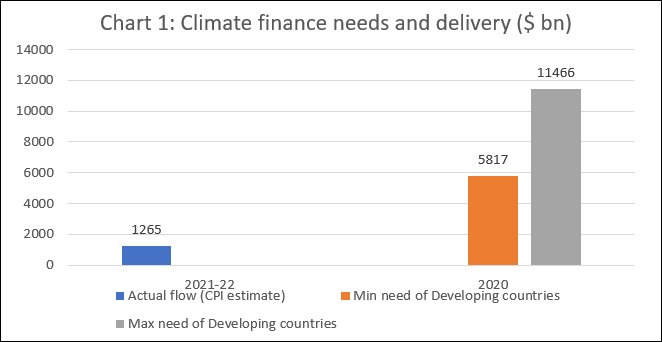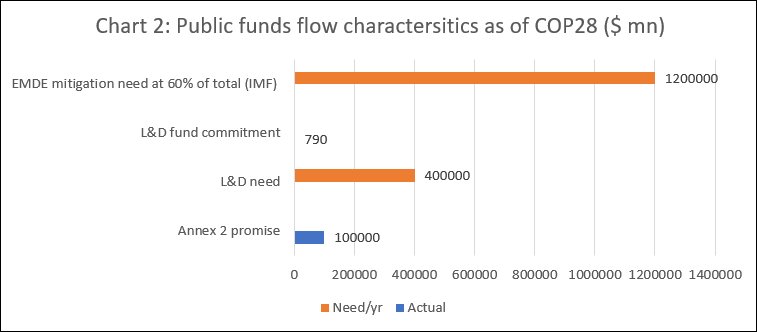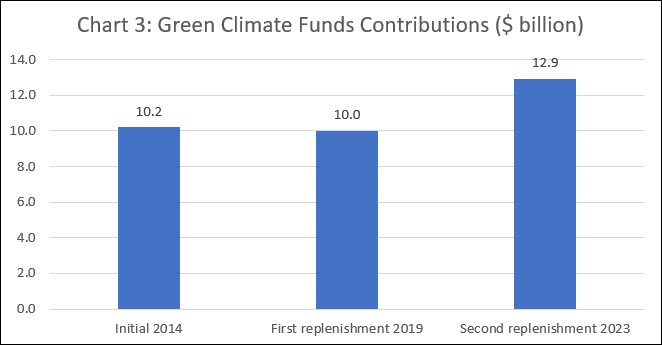From C.P. Chandrasekhar and Jayati Ghosh Following the COP28 Summit, there is an attempt to establish that the conference was a significant step forward in the effort to address the causes and consequences of climate change. However, a reading of the actual outcome only illustrates how the resistance of the developed countries to own up to their historical responsibility as emitters is stalling the effort to combat climate change and manage the consequences of the changes already underway. The COP process is ostensibly concerned with the global effort to move from an unsustainable trajectory to an acceptable one in terms of the ceiling on long-term warming (1.5-2°C). But in practice, it involves tweaking the way in which climate discourse is conducted, such that it is denuded of
Topics:
Editor considers the following as important: Uncategorized
This could be interesting, too:
tom writes The Ukraine war and Europe’s deepening march of folly
Stavros Mavroudeas writes CfP of Marxist Macroeconomic Modelling workgroup – 18th WAPE Forum, Istanbul August 6-8, 2025
Lars Pålsson Syll writes The pretence-of-knowledge syndrome
Dean Baker writes Crypto and Donald Trump’s strategic baseball card reserve
from C.P. Chandrasekhar and Jayati Ghosh
Following the COP28 Summit, there is an attempt to establish that the conference was a significant step forward in the effort to address the causes and consequences of climate change. However, a reading of the actual outcome only illustrates how the resistance of the developed countries to own up to their historical responsibility as emitters is stalling the effort to combat climate change and manage the consequences of the changes already underway.
The COP process is ostensibly concerned with the global effort to move from an unsustainable trajectory to an acceptable one in terms of the ceiling on long-term warming (1.5-2°C). But in practice, it involves tweaking the way in which climate discourse is conducted, such that it is denuded of history through a focus on the present. Thus, the emphasis is not on the shares in cumulative carbon emissions but on countries that are currently large emitters in the aggregate, even if not in per capita terms. The pressure is on for all countries to ensure “net” zero emissions, without reference to the disproportionate share of the available carbon budget appropriated historically by the rich nations in their race to development. That leaves untouched the question on what this would imply for development and diversification in high emitting low- and middle-income economies, striving to find their own route to the club of the developed.
In addition, there is an effort to push for the phasing out of fossil fuel, especially coal, dependence, without specifying which countries would be primarily responsible for technologically supporting and financing that transition in ways that make it just. Largely ignored is the issue of defining and identifying the levels and sources of “climate finance”. Once ‘differentiated responsibilities’ are defined not just in terms of the level of development, but in terms of cumulative emissions, the mobilization of climate finance (in terms of the quantum, source and direction of flow) would have to reflect a recognition of the case for reparation payments. Climate finance, as grants or on extremely concessional terms, must flow from the richest nations of today to the poorer countries whose development has been made immensely more difficult because of the need to rein in global warming by reducing carbon emissions
Thus far, progress has been limited to an implicit recognition of this, inasmuch as the public climate finance issue is a subject of (contentious) debate. More recently, there has also been formal recognition of the need for enhanced funding not just for mitigation that addresses the issue of the level of future emissions, but for adaptation and for dealing with loss and damage, which are now essential to manage and address the consequences of climate change. Since the developed countries have been largely responsible for that change, it was not surprising that developing countries listed in Annex 2 of the United Nations Framework Convention on Climate Change had accepted a special obligation to help developing countries with financial and technological resources required to reduce greenhouse gas emissions and curb global warming. However, this recognition has been accompanied by unrelenting opposition from the developed countries to any language that implies or explicitly states that they are primarily liable for past and ongoing global warming and are, therefore, responsible for facilitating adaptation and compensating countries for the loss and damage they suffer from the climate change consequences of that warming.
This has meant that any effort to link the financial contribution of individual countries to both the financing needs for mitigation, adaptation and L&D and a fair sharing of that burden based on responsibility (in terms of cumulative emissions per capita) and capability (in terms of their income per capita that has resulted from a carbon intensive growth trajectory) is anathema. The argument is that contributions must be voluntary and driven by altruism (as ostensibly development “aid” was). Further, there is no presumption that such “altruism” would take the form of public financial flows, in the form of grants or concessional loans. A large proportion of the flows is expected to be private and much of the financing from public sources would be on commercial terms.
The consequence of this reliance on voluntary contributions of uncertain substance has been alarming in two senses. First, there has been no relationship whatsoever between even the most conservative estimates of financing needs and the commitments made. Second, even the measly commitments made have not been adhered to. Worse still, even the commitment to contribute seems to be on the decline.
Chart 1 compares the 2020 estimates of the Standing Committee on Finance of the UNFCC of climate financing needs for mitigation and adaptation and loss and damage, with the estimate from Climate Policy Initiative for actual total (public and private) flows in 2021-22. While the needs of developing countries alone range between $5.8 trillion and $11.5 trillion a year, actual global finance in 2021-22 was just $1.3 trillion, revealing starkly the distance between needs estimates and actual flows.

But even that gap seems small when compared with the $100 billion a year (or 0.2 per cent of the SCF’s minimum needs estimate) the Annex 2 countries had promised by way of public finance by year 2020. Even the most expansive of climate finance estimates by the OECD finds that actual flows were close to $20 billion short of that figure by the target date. And it is still unclear that the low target has yet been realized—even as the actual content of the climate finance delivered so far is often suspect.
Meanwhile, there appears to be little willingness on the part of the developed countries, to pay as polluters must. Chart 2 captures the current state of play on public funds. The IMF estimates that currently 60 per cent of climate finance flows for mitigation are from public sources. The share of public finance would naturally be much higher for adaptation and L&D finance. At 60 per cent, the financing needs for mitigation of the emerging and developing economies (EMDEs) amounts to $1.2 trillion a year. The $100 billion a year of financing that developing countries have hitherto committed amounts to less than one per cent of that. Yet there was only limited progress at COP28 on defining the New Collective Quantified Goal that is expected to raise the floor from the $100 billion starting 2025.

Much has been made of the agreement to establish a Loss and Damage Fund (albeit hosted ‘temporarily’ by the World Bank, in the face of opposition to that arrangement from developing countries). But as compared with estimates of $115-435 billion a year in 2020 and rising to $290-890 billion a year by 2030 needed for the purpose (and around $400 billion a year in 2020 as estimated by the L&D Collaboration), commitments to the L&D fund thus far are a mere $790 million in total.
Similarly, the commitments to the Green Climate Fund, which is a channel for official flows over which developing countries have some say, have risen from an initial commitment of $10.2 billion in 2014 and $10 billion during the first replenishment in 2019 to just $12.9 billion in 2023 (Chart 3). And resources mobilized for the Adaptation Fund have fallen from $356 million at the time of COP26 in 2021 to $233 million at COP27 in 2022 and to just $165 million in 2023.

Thus, the developed countries neither accept that they are liable because of their role in driving climate change nor are willing to ‘altruistically’ contribute meaningful sums to addressing the problem. To legitimize that illegitimate stance, much is made of goal setting to achieve net-zero emissions or trebling renewable energy capacity and use. But such rhetoric cannot take the world closer to where it must get.
